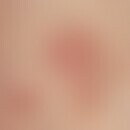General informationThis section has been translated automatically.
- Among the most important methods in operative dermatology are, besides near flap plasty, free skin transplants to cover excisional defects.
- Depending on the thickness of the flap, a distinction is made between a full skin transplant and a split skin transplant. When considering the most important indications for free skin transplantation, it must generally be borne in mind that a suitable graft bed must be available and the skin defect to be covered does not appear suitable for another surgical procedure either because of its extent, location or technical complexity (Fig. 1).
- Causes of an unsuitable graft bed are inadequate vascularization, such as exposed cartilage (missing perichondrium), tendons, cortical bone, traumatically damaged tissue by crushing, burning or radiation.
- Burning necroses must be removed down to in vital layers before transplantation. In the case of radiation damage, the entire fibrously indurated tissue layer must be resected. Regional arterial or venous insufficiency and systemic diseases often preclude free transplantation.
- The location of the recipient bed must be taken into account. For example, the cheek and perioral region are not suitable for free grafts (Fig. 2 a, b). For example, if a transplant bridges areas of greater mimic stress and a skin area that is hardly activated by muscle movement, such as at the transition from the lateral nose to the cheek, transplant necrosis, scar shrinkage and tissue hypertrophy must be expected.
- The choice of whether to use full skin, split skin flaps of varying thickness or mesh grafts for wound coverage depends on the respective indication. Since the different thickness of the grafts determines the later function, structure and pigmentation, this is an essential aspect in surgical planning (Figs. 3, 4, 5). Thin split skin flaps are the least demanding compared to the recipient bed. They leave hardly any traces at the donor site, but have the disadvantage of being subject to secondary shrinkage (Fig. 6, 7). Medium-thickness split skin often leads to hypertrophic scars at the donor site, but is hardly subject to secondary contractions. Thin split skin is mainly used in burn surgery and in areas of limited mobility, while medium-thickness split skin is beneficial in areas of greater stress and in children.
- The free full skin is the most demanding in terms of blood circulation in the recipient area, immobilization and forced tension. The causes of non-healing of transplants are haematomas, insufficient fixation and infections. It must be remembered that full-thickness skin grafts retain their properties corresponding to the donor site (Figs. 8, 9, 10).
- When selecting a suitable donor site, one should consider both the conspicuity of the resulting scar and the color of the graft. Full skin can be obtained from almost all parts of the body, including the scalp and extremities. If there is no excessive need for skin, grafts can be harvested from the lateral buttock side within the limits of a normal swimsuit. Lower extremity skin should not be used for face transplantation. The lateral neck region, the retroauricular region or the supraclavicular skin is more suitable for this purpose. In this case, the thin skin of the eyelid or preauricularly removed hairless full skin has the best cosmetic effect, especially for covering defects in cartilage- or bone-supported tissue (nose, auricle). For smaller full skin grafts to cover a defect on the fingertip, the inner side of the upper arm or the wrist or elbow region is preferred as donor region.
- After surgical removal of a keloid created in the incision scar and covering of the defect by means of free split skin, a relapse can also develop in the correctly guided suture line and despite a transplant that has healed without problems. Characteristic predilection sites for keloids are the shoulder, sternal region, auricle and neck area, but especially the neckline area in young women.
- In the case of split and full-thickness flaps, drainage holes can be made through graft incisions where there is an increased risk of haematoma formation due to the unevenness of the wound base. Grafts do not grow over an already epithelialised wound bed. Reverse positioning of the donor skin, severe tissue trauma or excessively thick or thin skin leads to failure. Seroma formation is to be expected if an operation is performed close to the lymph nodes. Lymphorrhoea, which can last for weeks, must be drained and compressed externally.
- If skin defects are not replaced, functional impairments may result. The defect left to secondary healing often leads to hypertrophic scarring. Scar shrinkage has different degrees of severity depending on its location. If, for example, after tumor excision in the area of the nostril, the defect is not covered, the edge of the nostril will be distorted cranially due to scar tissue shrinkage, with the subsequent complications of a crooked nose and obstruction of nasal breathing (Fig. 11 a, b).
LiteratureThis section has been translated automatically.
- Diem E (1984) Errors and complications of free skin grafts. In: Konz B, Braun-Falco O (ed.) Complications in operative dermatology. Springer, Berlin Heidelberg New York, p 83-6
- Kaufmann R, Podda M, Landes E (2005) Dermatological operations. Colour atlas and textbook on skin surgery. Thieme, Stuttgart New York
- Rudolph R, Fisher JC, Ninnemann JL (1989) Skin grafts. Thieme, Stuttgart New York
- Schulz H (1988) Operative dermatology of the face. Practical interventions. Diesbach, Berlin
- Sebastian G (1988) Functional and aesthetic late results after surgical treatment of lower lip tumors. In: Haneke E (eds.) Current status of operative dermatology, progress in operative dermatology, vol. 4 Springer, Berlin Heidelberg New York, p 108-121
















